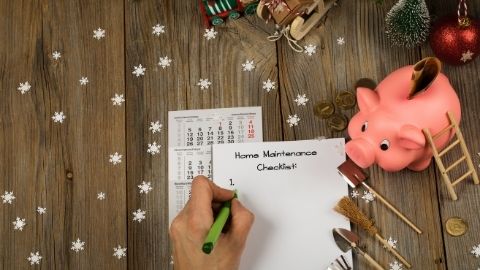Home Maintenance Checklist
Extension Assistant Professor, Andrea Schmutz
November 24, 2020

Entering the world of home ownership is likely one of the biggest investments you will ever make. To protect your investment, consider employing a couple of safeguards that will help you save money and retain the value of your home. First, create a category in your budget for home maintenance and repairs, and second, maintain a monthly and annual maintenance schedule. If you treat your home like your health or your car, and provide routine maintenance care, you can keep it running smoothly and working properly while incurring fewer costly repairs.
The Consumer Financial Protection Bureau’s budgeting worksheet suggests that a good rule of thumb is to budget approximately 1% of your home’s value annually to invest in maintenance and repair expenses. For example, if your home is worth $200,000, you would budget $2,000 per year to help cover maintenance costs. If you divide that by 12 months, you would need to save $167 per month.
The old adage, “An ounce of prevention is worth a pound of cure,” holds true for home maintenance. Performing routine maintenance on your home allows you to take care of small problems with relatively inexpensive solutions before they escalate into big, expensive problems. One home inspector explained that “for every $1 spent on maintenance, up to $100 of repairs are avoided. In my experience as a professional home inspector, I have looked at hundreds of homes in all age ranges, and I have seen thousands of dollars of damage to homes that could have been avoided by spending $5 to $10 and just a few minutes of work” (Roth, 2019). One such example would be purchasing a caulking gun and a tube of caulk for approximately $10-$20 to repair cracked caulk around exterior windows versus possible $3,000-$5,000 of water damage repair.
Home maintenance may seem daunting, but it doesn’t have to feel overwhelming. Start with a list of relatively simple tasks:
- Clean your gutters to allow proper drainage.
- Inspect your roof. While you are cleaning your gutters, look for missing, cracked or damaged shingles.
- Fix leaky faucets. This often just means replacing the rubber washer inside the faucet handle.
- Check your washer hoses and dryer lint trap/vent. Faulty washing machine supply and drain hoses are a leading cause of water damage. Remove lint and build up from the dryer vent to reduce the risk of fire.
- Replace your HVAC filters at least every six months, or 30-90 days if you have pets. Changing your filters regularly can prolong the life of your unit as well as help it run more efficiently.
- Trim shrubs and trees away from your house. Trees above your roof may encourage critters to make their way into your attic, and vegetation near your siding can encourage pests and water damage to your home’s structure.
- Inspect the caulking around your windows and recaulk if there are signs of cracks, gaps, or peeling.
- Caulk or regrout your tub showers and bathroom fixtures to protect against water damage.
- Clear your drains and clean your garbage disposal.
- Touch up exterior paint to keep moisture and wood rot at bay.
For a more detailed checklist, check out the National Center for Healthy Housing’s Home Maintenance Checklist that divides tasks by areas of the home and also by frequency and time of year. The University of Georgia Extension also offers a simple, yet thorough, home maintenance checklist.
Home maintenance may seem like an endless to-do list but remember that you don’t need to accomplish it all in one day. Use one of the recommended checklists or create one of your own to help you complete the tasks on a regular schedule. The key is not waiting until you have a major problem before you do something. A little prevention goes a long way with home maintenance and can save you money and time in the future.
References
-
Roth, J.D. (2019, November 14). Save money with regular home maintenance. Get Rich Slowly. https://www.getrichslowly.org/save-money-with-regular-home-maintenance/
-
Monthly payment worksheet. (n.d.). Consumer Financial Protection Bureau. https://files.consumerfinance.gov/f/documents/cfpb_buying-a-house_monthly-payment_worksheet.pdf
-
Healthy homes maintenance checklist. (n.d.). National Center for Healthy Housing. https://www.hud.gov/sites/documents/DOC_12334.PDF
-
Turner, P.R. & Bailey, L. (2020). Home maintenance checklist. University of Georgia Extension. https://secure.caes.uga.edu/extension/publications/files/pdf/C%201082_3.PDF

